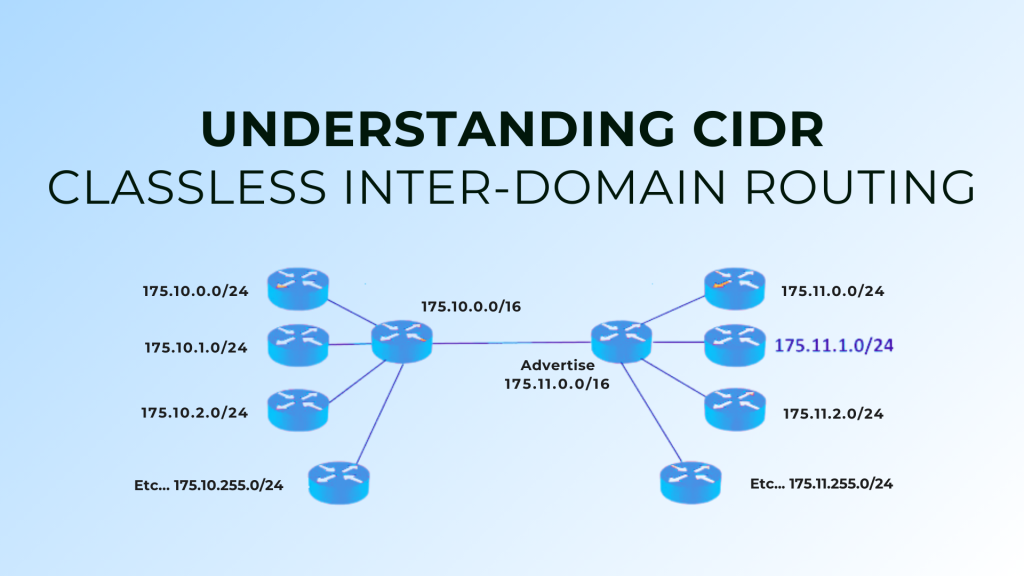Introduction to CIDR
CIDR, pronounced “cider,” stands for Classless Inter-Domain Routing. It is a method used for summarizing IP addresses, primarily designed to address the issue of IPv4 address exhaustion. By improving the efficiency of IP address assignments, CIDR has significantly enhanced the availability of IP addresses, extending the life of IPv4.
The Need for CIDR: A Look Back at Class-based IP Addresses
Before diving into how CIDR operates, it’s essential to understand the traditional class-based IP addressing system that CIDR replaced.
Classful Addressing System
In the early 1990s, internet engineers recognized that the existing method of allocating IP addresses was insufficient. Addresses were grouped into three classes:
- Class A: 16,777,216 addresses
- Class B: 65,536 addresses
- Class C: 256 addresses
This rigid system meant that if a user needed more addresses than were available in a Class C block, they had to acquire a Class B block, leading to significant inefficiencies.
IPv4 Address Anatomy
An IPv4 address consists of four decimal numbers separated by dots, such as 192.0.2.16, which corresponds to the binary representation 11000000.00000000.00000010.00010000. The first address in a network (the network address) always ends in zero in dotted decimal notation.
The Limitations of Classful Addressing
The classful system was easily recognizable by the structure of the address:
- Class A: First bit is 0
- Class B: First two bits are 01
- Class C: First two bits are 11
However, this limited flexibility made it clear that a more dynamic addressing method was necessary, leading to the development of CIDR.
How CIDR Works
The CIDR Structure
CIDR allows for a more efficient allocation of IP addresses by using variable-length subnet masking (VLSM). Instead of relying on fixed class sizes, CIDR enables the division of an IP address into subnets. A CIDR address comprises two components:
- Prefix: The binary representation of the network address, similar to a standard IP address.
- Suffix: Indicates the total number of bits in the address.
For instance, a CIDR notation like 192.168.125.23/16 signifies that the first 16 bits are used to define the network, allowing for a more precise allocation of addresses.
Subnetting and Supernetting
CIDR also supports subnetting, allowing networks to be divided into smaller segments. For example, a /20 network can be subnetted into multiple /24 networks, enhancing address utilization.
Moreover, CIDR facilitates supernetting, where multiple smaller subnets can be summarized into a larger address block. For instance, if different parts of a corporate network utilize various subnet sizes, these can be grouped under a single /22 supernet, optimizing the allocation of addresses.
The Advantages of CIDR
The transition from classful to classless addressing has introduced several key benefits:
- Improved Efficiency: CIDR minimizes wasted IP addresses by allowing more flexible address allocations.
- Extended IPv4 Life: By efficiently utilizing existing IP space, CIDR has slowed the depletion of IPv4 addresses.
- Support for IPv6: CIDR principles apply to IPv6 as well, which utilizes larger address spaces (up to 128 bits).
Conclusion
CIDR is a crucial advancement in IP address management, providing a more flexible and efficient way to allocate and manage IPv4 addresses. Its ability to support subnetting and supernetting has made it indispensable for network engineers. Understanding CIDR is essential for anyone involved in network design and management.
For further exploration of related topics, such as the differences between IPv4 and IPv6 or strategies for efficient network renumbering, consider researching additional resources.






